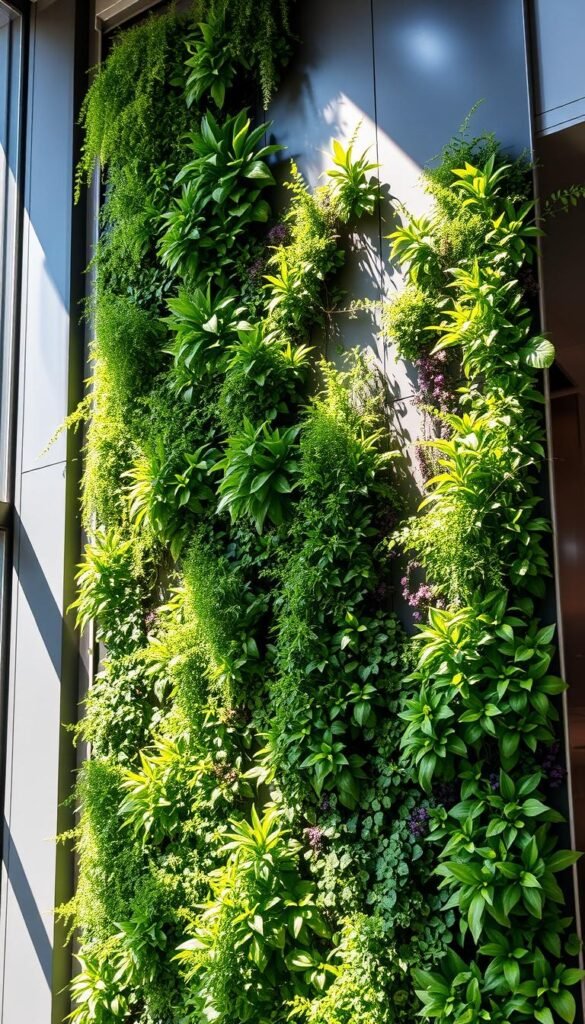Imagine turning blank walls into thriving plant displays that save floor space while adding life to your rooms. Whether you’re in a studio apartment or a cozy house, upward-growing greenery offers a smart way to cultivate plants where traditional pots won’t fit.
These creative setups do more than just look pretty. They purify air, reduce stress, and let you grow herbs or flowers year-round. You don’t need a backyard to enjoy fresh basil or vibrant blooms—just a little wall real estate and the right approach.
Modern designs range from modular panels to hanging pockets, fitting snugly in kitchens, bathrooms, or living areas. Many use self-watering systems, making care easier for busy schedules. Even better, they turn unused vertical surfaces into eye-catching focal points that reflect your personal style.
Ready to rethink how you use your walls? Let’s explore practical ways to create lush, living art that works with your space—not against it.
Embracing the Vertical Garden Lifestyle
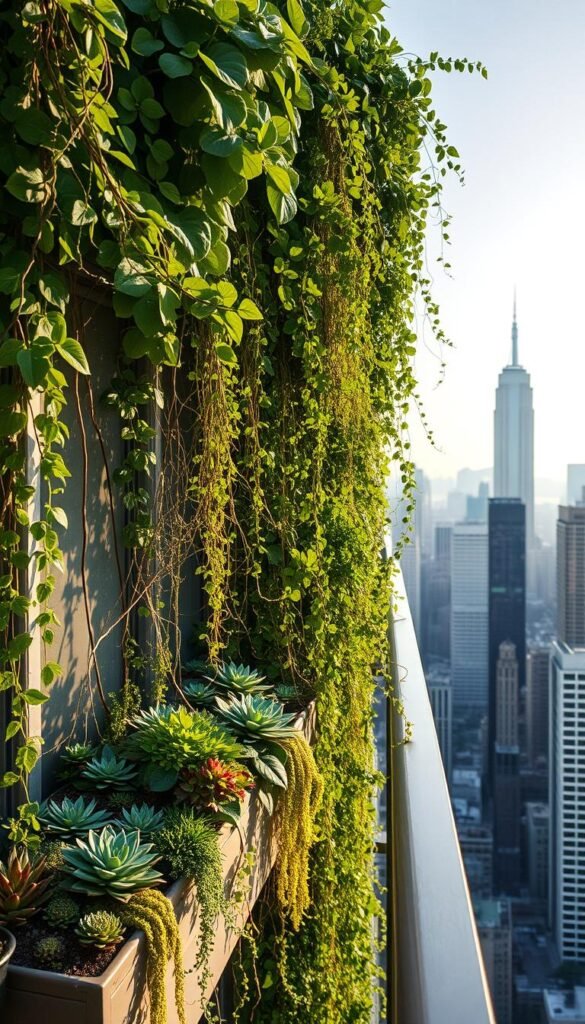
Transforming your home into a lush retreat starts with reimagining how greenery interacts with modern living. Whether you’re in a bustling city or a compact studio, upward-growing designs let you cultivate nature where traditional methods fall short.
Benefits of Vertical Gardens
These living installations do more than beautify—they refresh your air by filtering pollutants and boosting oxygen levels. Studies show surrounding yourself with leafy companions reduces stress by up to 37%, creating a calming atmosphere perfect for unwinding.
Ever notice how spaces feel stuffy? Vertical setups naturally regulate humidity, preventing mold while keeping rooms comfortable. They even muffle street noise, turning chaotic apartments into peaceful sanctuaries. One urban gardener notes: “My wall of ferns cut my AC use by 20% last summer.”
Maximizing Small Urban Spaces
City dwellers love how these systems turn narrow balconies or blank walls into thriving ecosystems. A single panel can hold 20+ plants, letting you grow herbs, flowers, or veggies without sacrificing square footage. Rotate sun-loving species near windows or shade-tolerant varieties in dim corners—every inch becomes productive.
Best part? Maintenance stays simple. Many modern designs include drip irrigation or self-watering reservoirs, perfect for busy schedules. You’re not just decorating walls—you’re building a living, breathing environment that evolves daily.
Indoor Vertical Garden Wall: Space-Saving Ideas for a Green Statement
Transform your empty walls into vibrant, living masterpieces that blend artistry with nature. Start by assessing your space—look for areas receiving 4-6 hours of indirect light daily, like near east-facing windows. Darker corners? No problem. Opt for low-light champions like pothos or snake plants that thrive without direct sun.
Choosing plants is half the fun. Mix textures and colors—pair trailing ivy with bold philodendrons or edible herbs like mint. For structural support, consider space-saving racks or modular panels that lock securely to surfaces. One homeowner shared: “Our fern wall survived three moves—it’s sturdier than my bookshelf!”
Design cohesion matters. Match your greenery to your room’s palette—silver-toned succulents pop against charcoal walls, while variegated plants brighten neutral schemes. Install drip trays to protect floors and use self-watering systems for hassle-free care. Rotate plants seasonally to keep displays fresh.
Ready to dive deeper? Continue reading for pro tips on balancing aesthetics with practicality. Learn layering tricks that make small spaces feel lush, and discover how proper drainage prevents root rot. Your living area deserves this breathable upgrade—one that grows more captivating with time.
DIY Inspirations: Colander Planter and Salvaged Trellis Projects
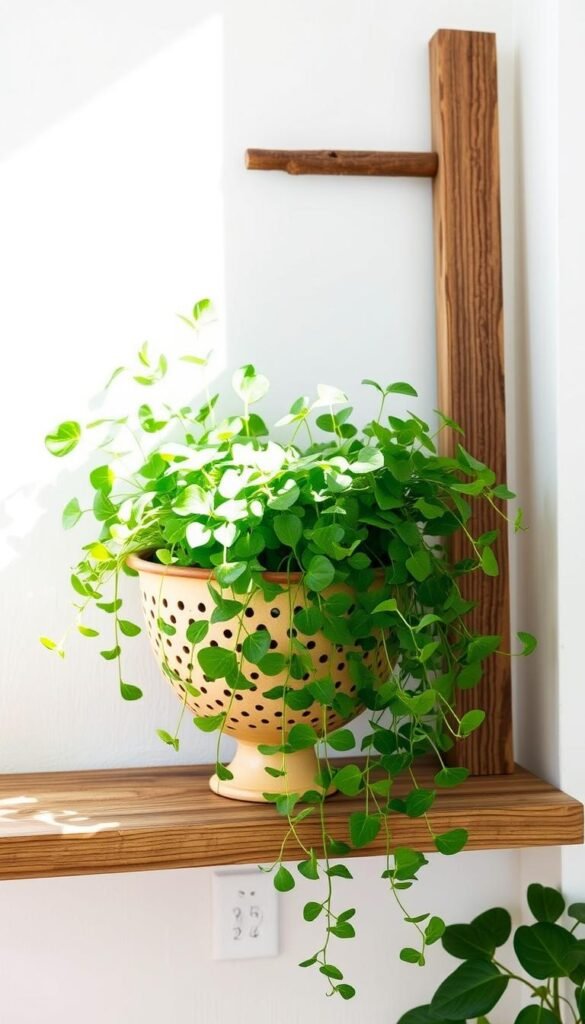
Breathe new life into forgotten kitchenware and architectural salvage with these inventive diy projects. That dusty colander? It’s moments away from becoming a whimsical home for trailing pothos or spider plants.
Repurposing Old Windows and Trellises
Start with a metal colander—drill drainage holes if needed. Line it with coconut coir, add soil, then plant your chosen greenery. Hang using S-hooks from ceiling mounts or wall brackets. One creative gardener shared: “My strawberry colander planter yields more fruit than my raised beds!”
Salvaged windows make excellent vine supporters. Carefully remove glass panes using protective gloves. Sand rough edges, then attach to walls with French cleats for easy removal. Star jasmine thrives here, releasing sweet scents as it climbs.
| Vine Type | Light Needs | Growth Speed | Wall Safety |
|---|---|---|---|
| Climbing Hydrangea | Partial shade | Slow | No damage |
| Star Jasmine | Bright indirect | Moderate | Roots harmless |
| Philodendron | Low light | Fast | Air roots safe |
Renters love removable adhesive hooks for temporary trellises. Homeowners can secure wooden frames directly into studs. Always use drip trays beneath planters to protect surfaces.
Continue reading for more budget-friendly hacks. Our next section reveals how hanging herb gardens transform kitchen windows into edible displays. Ready to turn salvaged finds into living art? Your walls await.
Hanging Planter Solutions for Every Space
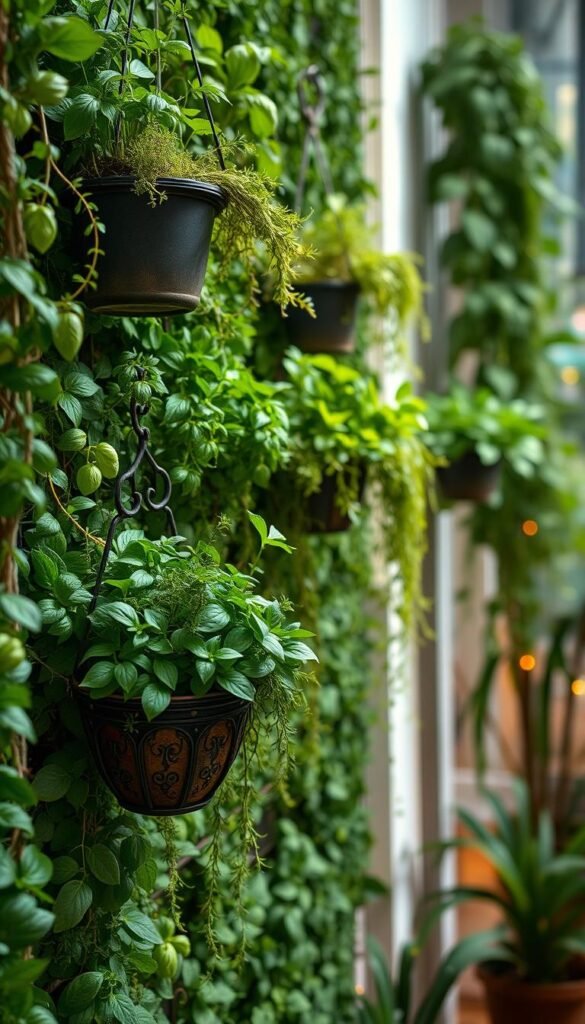
What if your kitchen window could double as a fresh herb pantry? Hanging planters turn underused vertical areas into productive green zones. They’re perfect for rooms where floor space is scarce but personality shouldn’t be.
Herb Garden Windows and Kitchen Displays
Position trailing rosemary or thyme where sunlight hits strongest—usually 6-8 inches from glass. Modular systems with adjustable hooks let you rearrange planters as plants grow. One urban chef notes: “My basil yield tripled after switching to hanging pots near the sink.”
Use self-watering inserts to prevent spills. Group 3-5 herbs at staggered heights for easy snipping. Mint thrives in solo containers to avoid overcrowding.
Elegant Brass Ring Planter Ideas
Brass rings add instant sophistication to small succulents. Thread leather cords through holes for adjustable lengths. Cluster 3-5 rings at varying levels to create movement.
Air plants love these open designs—mist weekly instead of watering. Pair with trailing ivy in matching metals for contrast. One designer shares: “Clients always ask about my brass ring display—it’s simpler than it looks!”
| Planter Type | Best Plants | Light Needs | Watering Tips |
|---|---|---|---|
| Macrame Hangers | Spider Plants | Bright Indirect | Soak weekly |
| Brass Rings | Air Plants | Medium Light | Mist 3x/week |
| Geometric Pots | Pothos | Low Light | Water every 10 days |
Continue reading to discover how ceiling hooks differ for drywall vs plaster. Learn which hardware holds 20+ pounds safely. Your hanging garden starts here—one stylish planter at a time.
Innovative Upcycled Planter Ideas
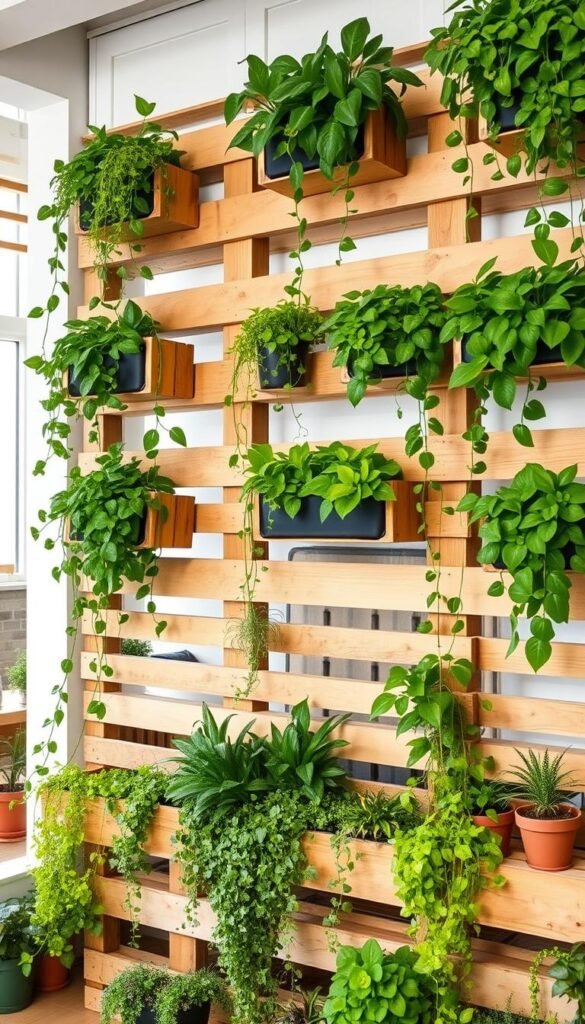
What if your next statement piece grew plants instead of collecting dust? Discarded materials like wooden pallets and old bins hold untapped potential for crafting eye-catching displays. With basic tools and creativity, you can turn overlooked items into functional art that breathes life into your space.
Creating Wall Units with Wooden Pallets
Start by sourcing untreated pallets—local hardware stores often give them away. Sand rough edges thoroughly, then apply two coats of outdoor-grade sealant to protect against moisture. One gardener swears by this method: “My sealed pallet survived three Chicago winters before needing a refresh.”
Mounting options adapt to your needs:
- Secure directly to studs using L-brackets for permanent installations
- Lean two pallets together in a teepee shape for renters
- Add casters to create mobile herb stations
When selecting greenery, consider weight limits. Succulents and herbs work best for vertical setups. Use these pairings:
| Planter Depth | Plant Type | Water Needs |
|---|---|---|
| 3-4″ | Sedums | Low |
| 6-8″ | Basil | Moderate |
| 10″+ | Strawberries | High |
Don’t overlook metal bins! Drill drainage holes in the base, then wrap with jute rope for texture. Paint them cobalt blue or sunflower yellow to complement your garden palette. These upcycled planters thrive on patios or as balcony accents.
Continue reading to discover how ladder shelving adds height to compact spaces. Learn which climbing plants pair best with salvaged materials. Your diy journey starts here—one transformed pallet at a time.
The Art of Ladder Shelving and Tiered Green Displays
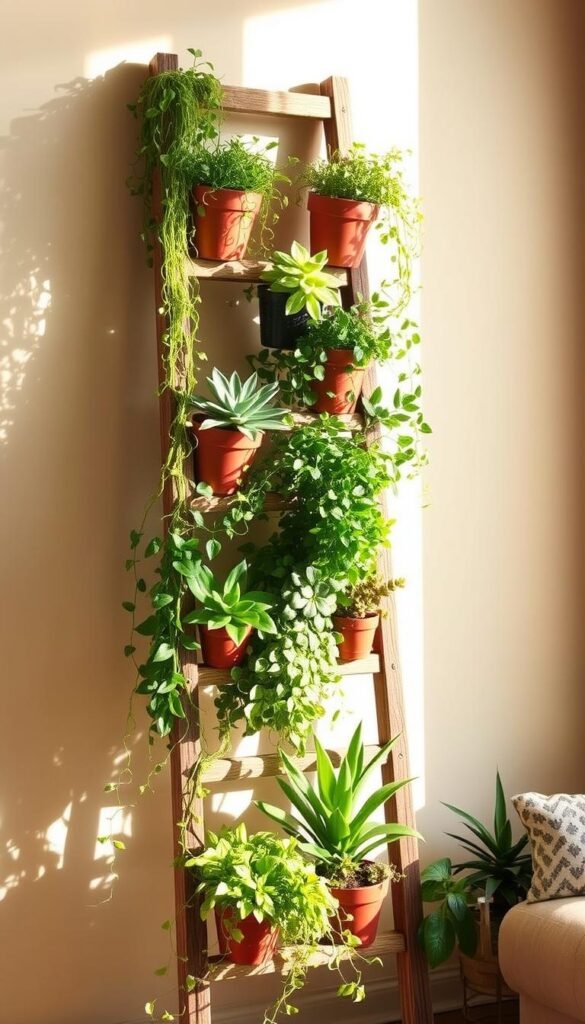
Elevate your greenery game with a timeless trick—transforming weathered ladders into multi-level plant stages. These structures add drama to blank areas while making every inch count, especially in snug rooms where horizontal surfaces vanish fast.
Using Rustic Materials to Add Height
Start with a sturdy wooden ladder—the more character, the better. Sand rough edges lightly to preserve patina, then secure it against your sturdiest surface using L-brackets. One thrifty gardener shared: “My great-grandpa’s orchard ladder held 18 pots through two Nor’easters without wobbling.”
No vintage find? Build your own with landscape timbers:
- Cut four 6-foot beams for vertical sides
- Attach 12-inch crossbars at 18″ intervals
- Treat wood with weatherproof stain
| Ladder Style | Best Materials | Weight Capacity | Plant Pairings |
|---|---|---|---|
| Farmhouse | Reclaimed oak | 40 lbs/shelf | Trailing ivy, herbs |
| Industrial | Galvanized pipes | 60 lbs/shelf | Succulents, air plants |
| Modern | Bamboo poles | 25 lbs/shelf | Orchids, moss walls |
Place thirstier specimens on lower rungs for easier watering. Top shelves suit drought-tolerant varieties. Always anchor the base with rubber grips or wall ties—a loaded ladder weighs more than you’d guess!
Continue reading to explore bamboo trellis designs that complement these displays. Learn how climbing varieties interact with different materials for seamless indoor-outdoor flow.
Bamboo Trellis and Living Wall Options
Ever dreamed of adding natural architecture that grows more striking each day? Bamboo’s flexibility and strength make it ideal for crafting organic supports that double as artistic statements. These systems bring texture to bare areas while giving climbing plants room to shine.
Crafting a Focal Rustic Look
Start with 4-6 bamboo poles cut to your desired height. Use jute twine to lash them into pyramid shapes or grid patterns—no fancy tools needed. One DIY enthusiast shared: “My 6-foot tuteur took 20 minutes to build and became our living room’s main attraction.”
Salvage materials creatively:
- Use fallen branches as crossbars
- Repurpose old belts as rustic ties
- Anchor bases in decorative planters
Train fast-growing vines like morning glories using soft plant ties. Guide tendrils clockwise for even coverage. Rotate structures weekly to prevent leaning.
| Vine Type | Light Needs | Bloom Time | Training Tips |
|---|---|---|---|
| Black-Eyed Susan | Bright indirect | Summer-Fall | Pinch tips for bushiness |
| Moonflower | Full sun | Night blooms | Use wider mesh supports |
| Cypress Vine | Medium light | Mid-Summer | Trim spent flowers |
Position your trellis where it naturally draws the eye—behind sofas or flanking entryways. Keep 12-18 inches between structures and furniture for easy access. Continue reading to discover how these designs complement modern landscape trends while staying functional.
Succulent Wall Gardens and Modern Installations
Turn your walls into living canvases with drought-resistant beauty. These low-maintenance displays thrive where other plants struggle, transforming sun-drenched areas into textured focal points. Their shallow roots make them perfect candidates for slim vertical setups.
Designing Shallow-Root Displays
Start with modular containers designed for vertical growth—many come with built-in drainage pockets. Mix rosette-shaped echeverias with trailing sedums for dynamic contrast. One urban designer notes: “My clients love how these arrangements evolve slowly, like living sculptures.”
Watering needs differ from traditional gardens:
| Succulent Type | Light Needs | Watering Frequency | Growth Rate |
|---|---|---|---|
| Haworthia | Bright indirect | Every 3 weeks | Slow |
| Burro’s Tail | Direct sun | Monthly | Moderate |
| String of Pearls | Medium light | Every 2 weeks | Fast |
Propagate cuttings by tucking them into soil-filled crevices. Rotate displays quarterly to ensure even sun exposure. In winter, reduce watering to once monthly—these hardy succulents prefer neglect over fuss.
Continue reading to discover how lettuce walls offer edible alternatives. Learn which herbs thrive in similar setups and how to prevent soil compaction over time.
Vertical Doorway and Garden Shed Transformations
What if your front door became the neighborhood’s most charming feature? Climbing vines winding through arched trellises turn ordinary entries into storybook scenes. Start by selecting durable plants like clematis or climbing roses that thrive in your local climate.
Partner with a landscape pro when installing permanent structures. They’ll ensure proper anchoring and suggest materials resistant to weather damage. One homeowner shared: “Our jasmine-covered arch survived three hurricanes—it’s sturdier than our garage!”
| Plant | Bloom Time | Foot Traffic Tolerance |
|---|---|---|
| Sweet Pea | Spring-Summer | Moderate |
| Trumpet Vine | Summer-Fall | High |
| Honeysuckle | Year-round | Low |
Garden sheds get glamorous upgrades too. Mount half-round planters on exterior walls for cascading flower displays. Petunias and lobelia spill over edges beautifully, while waterproof liners protect wooden surfaces.
Maintain high-traffic areas by trimming tendrils weekly. Use slow-release fertilizer to keep blooms vibrant. With smart planning, even functional spaces become enchanting extensions of your garden.
Continue reading to explore customized planter styles that blend seamlessly with your décor. Discover how to match materials and colors for cohesive indoor-outdoor flow.
Customized DIY Vertical Planters for Indoor Spaces
Who says your planters can’t be as stylish as your furniture? With basic tools and imagination, you can craft pieces that elevate your home’s aesthetic while nurturing greenery. Start with affordable hanging pots—they’re blank canvases waiting for your personal touch.
Tailoring Planter Styles to Match Your Décor
A flat-finish spray paint instantly upgrades plastic containers to match your room’s color scheme. Add texture with jute rope wrapped around edges or geometric patterns using washi tape. One crafter transformed dollar-store finds into boho-chic displays by mixing metallic paints with macrame hangers.
For wood enthusiasts, small cedar scraps become rustic wall-mounted boxes. Sand surfaces smooth, then join pieces with waterproof glue. Pre-drill holes to prevent splitting when mounting. Pro tip: Stain wood before assembly for seamless coverage.
Get tutorial-ready solutions for tricky walls. Use toggle bolts for drywall or masonry anchors for brick. Space planters 10-12 inches apart for visual balance. Cluster odd numbers (3 or 5) at varying heights to create rhythm without clutter.
Your diy journey starts here: swap generic pots for creations that tell your story. Every brushstroke or knot becomes part of your living art.

